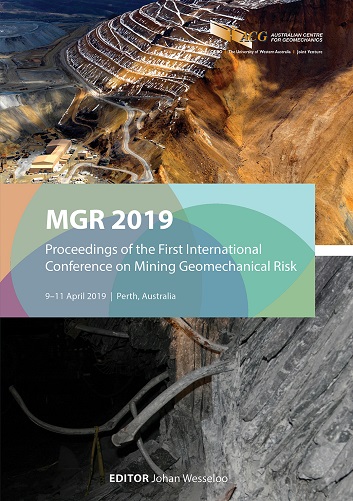Getting back to basics: risk fundamentals applied to the geotechnical engineering of tailings storage facilities

|
Authors: Coffey, JP; Susic, N |
DOI https://doi.org/10.36487/ACG_rep/1905_25_Coffey
Cite As:
Coffey, JP & Susic, N 2019, 'Getting back to basics: risk fundamentals applied to the geotechnical engineering of tailings storage facilities', in J Wesseloo (ed.), MGR 2019: Proceedings of the First International Conference on Mining Geomechanical Risk, Australian Centre for Geomechanics, Perth, pp. 419-428, https://doi.org/10.36487/ACG_rep/1905_25_Coffey
Abstract:
Inherent uncertainty associated with the selection of input parameters to various geotechnical analyses often results in the likelihood of failure being a dominant topic in the discussion of risk associated with geotechnical assets. As a result, embankment failure is the default risk scenario driving ongoing management of tailings storage facilities (TSFs). This commonly applied approach is inefficient as it drives resource intensive TSF management and limits scope for a risk-based approach. However, many TSFs operate with several layers of controls in place. Therefore, assessment of risk with consideration of these controls would promote greater efficiency in TSF management. A fit for purpose approach will be discussed that demonstrates how risk can be utilised as the foundation for the development of a management framework for a single or portfolio of TSFs. This approach focuses on the identification and monitoring of controls, based on the understanding that hazards impact when the controls put in place to manage them fail. It is necessary to build such an approach with the full application of risk principles, which will be introduced by a specialist in corporate risk. Topics covered include a brief history of risk, importance of control effectiveness in scenario selection and risk evaluation and communicating value at risk to drive resource allocation. It is hoped that this discussion and presentation of simple examples allows risk concepts to be better applied to the design and management of geotechnical structures.
Keywords: tailings storage facility, risk, Probability of Failure, controls
References:
Arnauld, A & Nicole, P 1996, Logic or the Art of Thinking, Cambridge University Press, Cambridge.
ANCOLD 2012, Guidelines on Tailings Dams – Planning, Design, Construction, Operation and Closure, Australian National Committee on Large Dams, Hobart.
Aven, T & Renn, O 2009, ‘On risk defined as an event where the outcome is uncertain’, Journal of Risk Research, vol. 12, no. pp. 1–11.
Azam, S & Li, Q 2010, ‘Tailings dam failures: a review of the last one hundred years’, Geotechnical News, vol. 28, pp. 50–53.
Blight, GE & Fourie, AB 2003, A Review of Catastrophic Flow Failures of Deposits of Mine Waste and Municipal Refuse, introductory report of the International Workshop on Occurrence and Mechanisms of Flows in Natural Slopes and Earthfills, 14–16 May 2003, Sorrento.
Boshoff, J 2015, ‘Responsible tailings management’, Proceedings of the First Tailings and Mine Waste Management for the 21st Century Conference, The Australasian Institute of Mining and Metallurgy, Melbourne.
Bruce, IG & Oboni, F 2002, ‘Risk-management process for tailings control’, Mining Engineering, vol. 54, no. 10, pp. 14–17.
Christian, JT, Ladd, CC & Baecher, GB 1994, ‘Reliability applied to slope stability analysis’, Journal of Geotechnical Engineering, vol. 120, no. 12, pp. 2180-2207.
Dai, SH & Wang, MO 1992, Reliability Analysis in Engineering Applications, Van Nostrand Reinhold, New York.
Duncan, MJ, 2000, ‘Factors of safety and reliability in geotechnical design’, Journal of Geotechnical and Geoenvironmental Engineering, vol. 126, no. 4, pp. 307–316.
International Organization for Standardization 2018, ISO 31000:2018 Risk Management – Guidelines, International Organization for Standardization, Geneva.
Martin, TE & Davies, MP 2002, Trends in the Stewardship of Tailings Dams, AGRA Earth & Environmental Limited, Burnaby.
McPhail, GI 2017, ‘Water management measures at TSFs and problems related to poor management’, Management, Operation and Relinquishment of Tailings Storage Facilities Seminar, 29–30 April, Perth.
MAC 2017, A Guide to the Management of Tailings Facilities, 3rd edn, The Mining Association of Canada, Ottawa.
Murray, L, McLeod, H & Suter, G 2010, ‘Effectiveness in risk assessment – a comparison of perceived and realised risk from project concept to construction and operation’, Proceedings of the First International Seminar on the Reduction of Risk in the Management of Tailings and Mine Waste, Australian Centre for Geomechanics, Perth, pp. 217–228.
Oboni, F & Oboni, C 2016, A Systematic Look at Tailings Dams Failure Process, Riskope, Vancouver.
Payne v TIWEST Pty Ltd 2005, WASC 141.
PricewaterhouseCoopers 2012, 15th Annual Global CEO Survey 2012, PricewaterhouseCoopers, London, 40 p.
Sotic, A &Rajic, R 2015, ‘The review of the definition of risk’, Online Journal of Applied Knowledge, vol.3, issue 3, pp. 17–26.
The Institute of Internal Auditors 2013, IIA Position Paper: The Three Lines of Defense in Effective Risk Management and Control.
US Department of the Interior Bureau of Reclamation 2015, Best Practice in Dam and Levee Safety Risk Analysis, US Department of the Interior Bureau of Reclamation, Washington DC.
© Copyright 2025, Australian Centre for Geomechanics (ACG), The University of Western Australia. All rights reserved.
View copyright/legal information
Please direct any queries or error reports to repository-acg@uwa.edu.au
View copyright/legal information
Please direct any queries or error reports to repository-acg@uwa.edu.au
